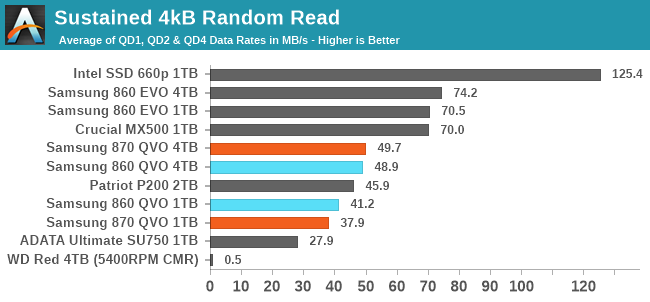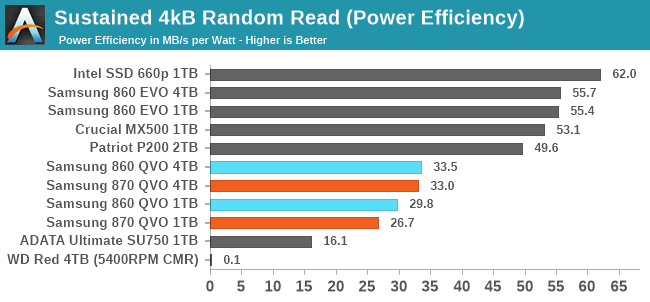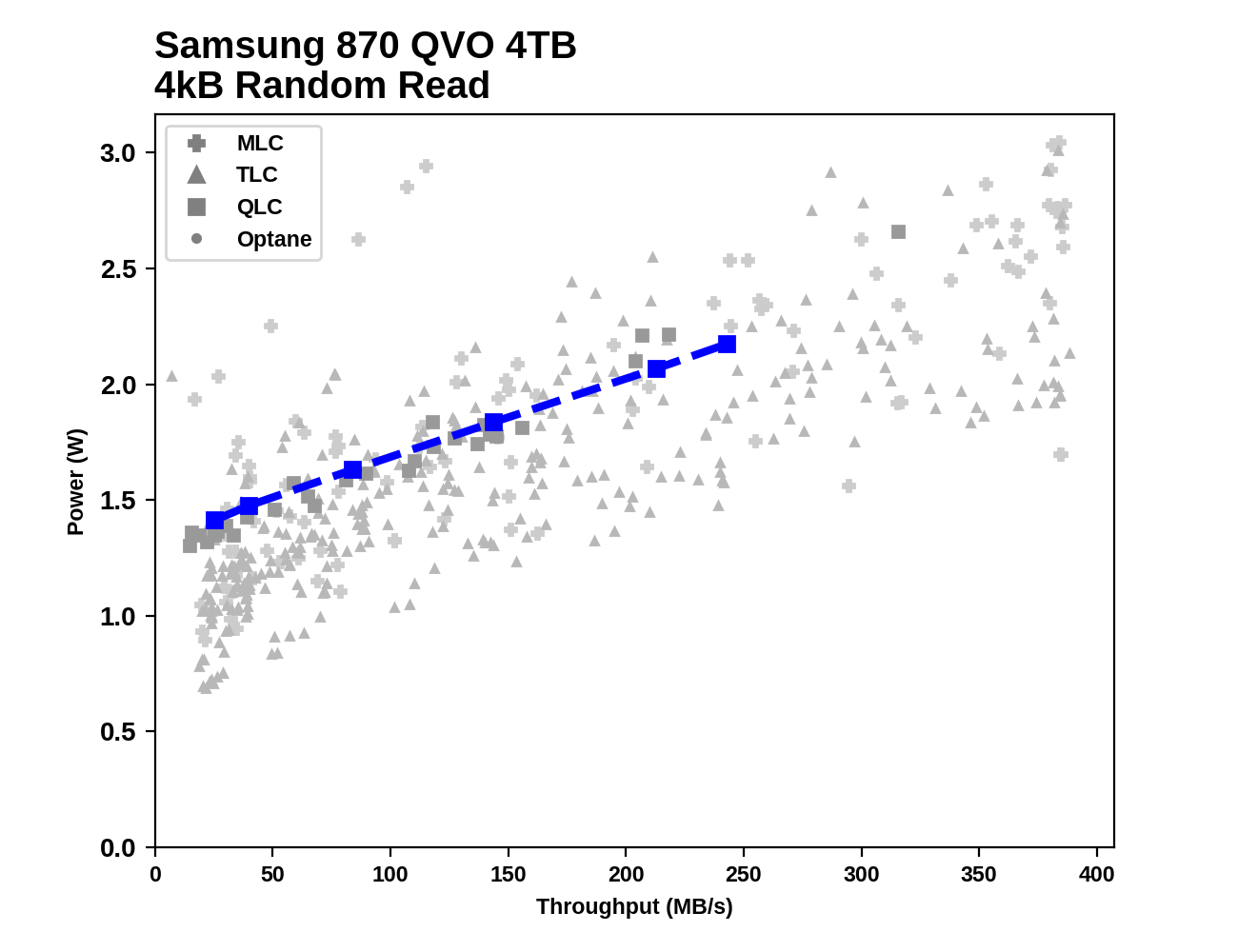The Samsung 870 QVO (1TB & 4TB) SSD Review: QLC Refreshed
by Billy Tallis on June 30, 2020 11:40 AM ESTBurst IO Performance
Our burst IO tests run at a queue depth of one and the amount of data transferred is limited to ensure that SLC write buffers don't fill up and controllers don't overheat. In between each burst there's enough idle time to keep the drive averaging a 20% duty cycle, allowing for some buffered writes and deferred garbage collection to be completed. The random read and write tests use 4kB operations and the sequential tests use 128kB operations. All the burst tests are confined to a 16GB portion of the drive, so DRAMless SSDs are not disadvantaged as much as they are for larger tests.
 |
|||||||||
| Random Read | Random Write | ||||||||
| Sequential Read | Sequential Write | ||||||||
The Samsung 870 QVOs show significant improvement to QD1 random read performance, with the 1TB model still outperforming the 4TB model. QLC still imposes a bit of a performance penalty relative to mainstream SATA drives, but the biggest difference on display here is naturally from the NVMe drive serving the reads entirely out of its huge SLC cache.
For random writes at QD1, the 870 QVO is a stark regression from its predecessor, which was on par with the TLC-based 860 EVO. The 870 QVO is now clearly slower than mainstream TLC SSDs and is barely faster than the slower DRAMless competitor.
Sequential reads and writes at QD1 both show slight improvements, but these drives are almost all simply bumping against the limits of the SATA interface.
Sustained IO Performance
Our sustained IO tests measure performance on queue depths up to 32, but the scores reported here are only the averages for the low queue depths (1,2,4) that are most representative of real-world consumer workloads. Each queue depth is tested for up to one minute or 32GB, and the tests are confined to a 64GB span of the drive.
 |
|||||||||
| Random Read | Random Write | ||||||||
| Sequential Read | Sequential Write | ||||||||
 |
|||||||||
| Random Read | Random Write | ||||||||
| Sequential Read | Sequential Write | ||||||||
The most notable performance changes the 870 QVO brings to the sustained IO tests are from the 1TB model, which has greatly improved both random and sequential write performance. However, this comes at the cost of reduced random read performance, which is also a weakness for the 4TB model.
Power efficiency from the 870 QVOs during the sustained IO tests ranges from poor to average. Samsung's controller and LPDDR4 help keep power draw in check, but ultimately it takes more energy to operate slower, more complicated QLC NAND.
 |
|||||||||
| Random Read | Random Write | ||||||||
| Sequential Read | Sequential Write | ||||||||
Looking at the big picture of the 870 QVO against all the other drives we've tested shows that the 870 QVO can reach the same top speeds as most SATA drives for three out of the four workload types. Random reads are the exception, where even high queue depths don't bring the 870 QVO up to the SATA limits during our sustained test, and the power draw is clearly on the high side there as well.
 |
|||||||||
| Random Read | |||||||||
| Random Write | |||||||||
| Sequential Read | |||||||||
| Sequential Write | |||||||||
Compared to its predecessor, the 870 QVO brings slight improvements to random read performance, mainly at higher queue depths, while keeping power consumption almost unchanged. Random write performance has changed drastically for the 1TB QVO: the 1TB 870 is able to ramp up to much higher random write speeds, keeping pace with the 4TB model until the very end of the test when the smaller drive's cache finally runs out in spite of the idle time between phases of the test. The older 1TB 860 QVO's random write speed was constrained almost from the very beginning of the test. The 1TB 860 QVO also used to show a bit of fall-off in sequential read performance as the test reached higher capacities, and that behavior is gone with the 870 QVO. Sequential writes show a similarly drastic improvement for the 1TB 870 QVO, now able to generally keep pace with the larger model, which was not remotely the case for the previous generation.
Some of the big differences in write speed shown for the 1TB QVOs here may be an artifact of this test's size and duration, but even so it is clear that the smallest QV










64 Comments
View All Comments
akramargmail - Tuesday, June 30, 2020 - link
So this is better for Samsung, but not for me. Never wanted the 860 QVO and see no reason to change my mind.yeeeeman - Tuesday, June 30, 2020 - link
I agree. Samsung is losing a big chance with this line of SSDs by pricing them very high for what they can do and what competition they have.Urwni - Tuesday, June 30, 2020 - link
Yeah, 860 EVO is still competitive, considering its price, performance and reliability.Great_Scott - Thursday, July 2, 2020 - link
Ahhh. The late great 870 QVO. Perfect match in price and (mostly) performance with major mfr TLC drives.It has no reason to exist at the price point it's sold at. A shame.
B Huggy - Monday, July 6, 2020 - link
"So this is better for Samsung, but not for me. Never wanted the 860 QVO and see no reason to change my mind."Love it - you don't even own it, but somehow it's bad for you. :D
shabby - Tuesday, June 30, 2020 - link
Approaching hdd speeds... congrats samsung 👏👏👏leexgx - Sunday, July 5, 2020 - link
For £0-10 saving I can get this QLC drive (£90 new), just not worth it for the possible slow down compared to a Samsung evo or Crucial mx500 (£90 to £100 new, or less used)Needs to be significantly cheaper
Jorgp2 - Tuesday, June 30, 2020 - link
Those prices are terribleSomeguyperson - Tuesday, June 30, 2020 - link
As Anand said, "There are no bad products, only bad prices".Jorgp2 - Tuesday, June 30, 2020 - link
Whereas Linus says, "It's a bad product if it will get me clicks".